Proj.iasri.res.in
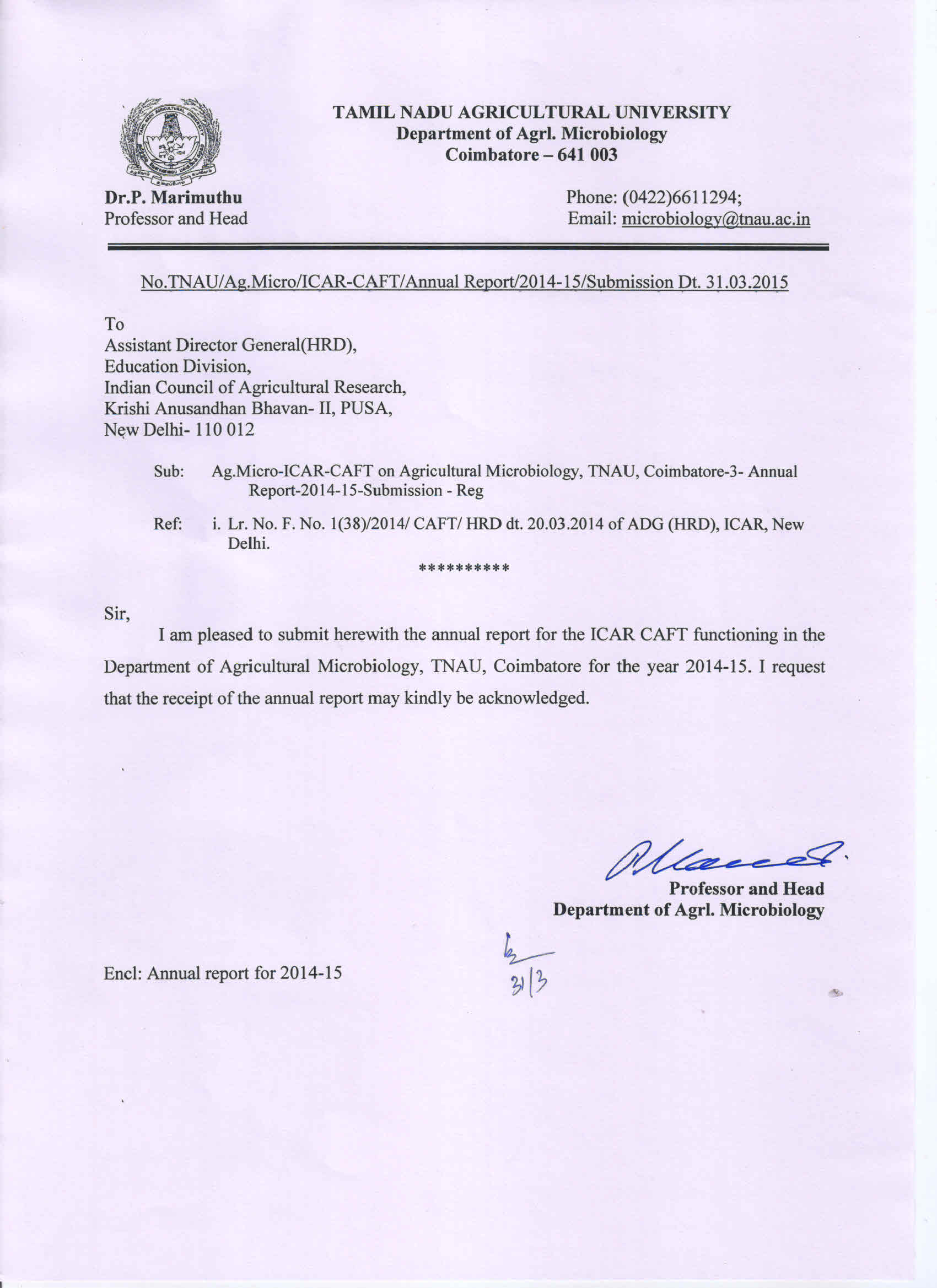
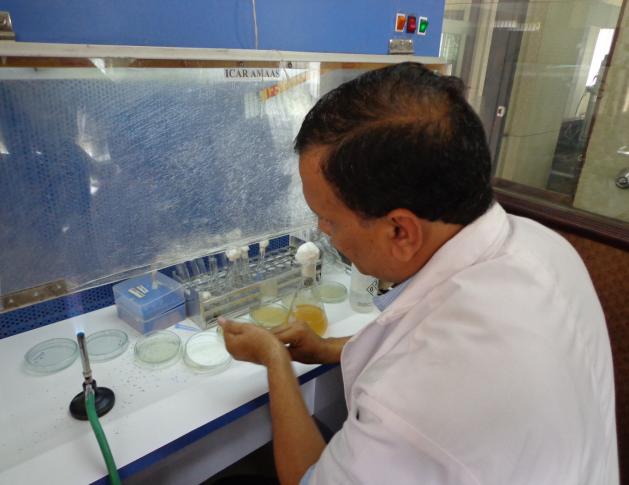
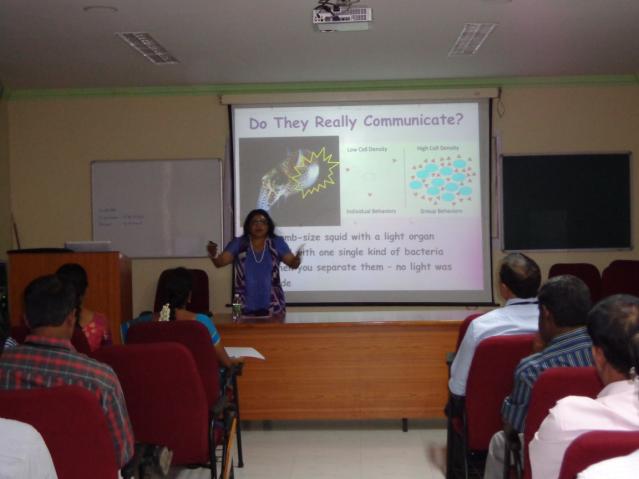
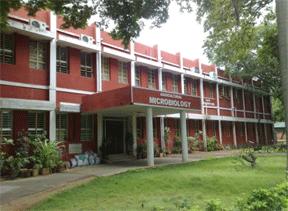
ICAR Sponsored
Centre of Advanced Faculty Training in Agricultural Microbiology
Annual Report (2014-15)
Department of Agricultural Microbiology
Directorate of Natural Resource Management
Tamil Nadu Agricultural University
Coimbatore - 641 003
ANNUAL REPORT
Centre of Advanced Faculty Training in Agricultural Microbiology
General information
1.
: Centre of Advanced Faculty Training in Agricultural Microbiology
: Council 's letter number 1-2-/93 (CAS) dated 11-11- 1994 of
Assistant Director General (UNDP), Krishi Bhavan, New Delhi
Date of Inception
Reporting period
Name of the institute
: Department of Agrl. Microbiology
Tamil Nadu Agricultural University Coimbatore 641 003
Name of the Post
Scale of Pay
Sanctioned
Steno cum typist
Rs. 5,200 – 20,200 +
7. Technical programme
To strengthen the UG and PG programme in Agricultural Microbiology To strengthen the research activities in one of the important areas of Agricultural Microbiology. To offer training to scientists and faculty members of state agricultural universities and central
To upgrade the research and teaching facilities in Agricultural Microbiology.
8. Budget allocation and expenditure statement for 2014-15 (Rupees)
Cost of personnel
Training programme
Recurring contingencies
8,54,990
10,12,909
(-) 1,32,909
9. Training programmes to be conducted during 2015-16
Particulars
Training
2nd to 22nd September, 2015
Microbial mediated soil-nutrient transformation
Course coordinators
Dr R.Sridhar, Professor (Microbiology) Dr. T.Kalaichelvi , Professor (Microbiology) Dr. D.Balachander, Professor (Microbiology)
Number of participants
10. List of Topics for Future programmes
Advances in soil biotechnology Antimicrobials from microbial sources and their applications Recent advances in food fermentation Fermented foods and beverages Microbiological techniques for food processing Plant microbe interactions Microbial transformations in soil
ANNEXURE I
Training Details
ICAR-CAF training on
ICAR sponsored Centre for Advanced Faculty Training on
"Biocatalysts for fuels and chemicals from biomass"
(7th to 27th August, 2014)
COURSE OUTLINE
Principles of Biorefining - Biorefinery approaches for fuels and chemicals from crop biomass and
residues - Potential bioresources as future sources of biofuels - Overview of second generation
bioethanol and renewable chemicals from lignocellulosics - Lifecycle assessment of biofuels -
Lignocellulosic bioethanol: Current status and future perspectives – Techno-economic analysis of
lignocellulosic ethanol - Pretreatment technologies for lignocellulose to bioethanol conversion –
Evaluation of physical, chemical and enzymatic pre-treatment technologies – Biocatalysts for biomass
destructions - Production of cellulolytic enzymes for the hydrolysis of lignocellulosic biomass -
Production of hemicellulolytic enzymes for hydrolysis of lignocellulosic biomass - Hydrolysis of
lignocellulosic biomass for bioethanol production - Production of bioethanol from agro-industrial
residues as feedstocks - Fermentation Inhibitors in ethanol processes and different strategies to reduce
their effects – Biomass derived lignin products; Production of biodiesel from algal biomass: Current
perspectives and future - Overview and assessment of algal biofuels - Production technologies -
Cultivation of algae in open systems and photobioreactors for biodiesel production; Production of
Biohydrogen: Current perspectives and future Prospects - Butanol fuel from biomass: revisiting ABE
fermentation - Production of green liquid hydrocarbon fuels – Biomethanation - Biogas production from
anaerobic treatment of agro-industrial wastewater - Biomass gasification: ways of generating biomass
carbon and bio-oil for biofuels production; Thermochemical conversion of biomass to biofuels – Biomass
-derived syngas fermentation into biofuels - The future of biofuels and biofuels of the future.
List of resource personnel
A.
Faculty members
Name and Designation of Faculty
Major areas of research
Dr. S. Gunasekaran,
Fermentation microbiology; Food fortification; Value addition
Professor and Head
of Agricultural products
Biologial nitrogen fixation; Biofertilizer technology;
Diazotrophic diversity; Soil metagenomics; Food fermentation
Dr. R. Murugesan, Professor
Industrial microbiology; Value added products; Antimicrobial compounds; Anaerobes; Biofertilizers
Dr. P. Marimuthu, Professor
Antimicrobial compounds
Dr. K. Ilamurugu, Professor
Soil microbiology; Biological nitrogen fixation; Anaerobes Nanobiosensors
Dr. G. Prasad, Professor
Bioconversion and Environmental microbiology
Dr. K. Vijila, Professor
Food and Fermentation Microbiology; Microbial nutraceuticals and functional foods;
Dr. V. Gomathy, Professor
Solid waste management; Soil aggregation; Liter degradation
Dr.Z.John Kennedy, Professor
Food Microbiology and safety
Dr.N.O.Gopal, Professor
Dr.R.Sridhar,Professor
Food preservation , Probiotics Soil Microbiology
Dr. S. Karthikeyan, Professor
Fermentation technology; Environmental Biotechnology; algal biofuels
Dr. K. Kumutha, Professor
PGPR; AM biofertilizer
Dr. U. Sivakumar, Professor
Lignin degradation; Laccase production; Biofuels
Dr.T.Kalaichelvi, Professor
Biofuels, Forest Microbiology
Dr. M. Senthil Kumar,
Rhizosphere engineering using phages; nanotechnology in food
Assistant Professor
Dr. M. Gnanachitra,
Biofertilizers; formulations and delivery systems
Assistant Professor Dr. R. Subhashini,
Probiotics, Microbial inoculants and formulations
Assistant Professor Dr. R. Brindavathy,
Soil microbiology; PGPR
Assistant Professor
B.
Other scientists of TNAU, Coimbatore
Name and Designation of Faculty
Major areas of research
Biomethanation and bioenergy for rural
Professor & Head, Dept.of Bioenergy,TNAU,
housing and small scale industries
Coimbatore- 3 Dr. R. Murugesan
Bioprospecting microbes for high value
Director,ABD,TNAU,Coimbatore- 3
Nanomaterials and SEM imaging
Professor, Dept. of Nanoscience and nanotechnology Dr. S. Marimuthu
Biopolymers and nanomaterials for value
Assistant Professor, Dept. of Nanoscience and
nanotechnology
C. Experts from other institutions
Name and address
1. Dr.K.Gurumuthy
Former Director, IFGTB, 62/4, Block-2, Second Floor, Leela Apartments, Ponnayarajapuram, Coimbatore-641001
2. Dr.Kalai mathee
Professor & Head, Herbert Wertheim College of Medicine, Florida International University, University Park, Miami, Florida, USA
3. Dr.Palani Shanmugam
Principal Scientist Department of Environmental Technology, CLRI, Adyar, Chennai – 600 020
4. Mr.Sudhagar
DGM , Sakthi Sugars,
Appakudal, Bhavani taluk, Erode
5. Dr. R.S. Prakasham
Sr.Scientist Indian Institute of Chemical Technology Tarnaka, Hyderabad
6. Dr. Mageshwaran V
Scientist Chemical and Biochemical Processing Division, (CIRCOT), Matunga (E), Mumbai-19.
7. Dr. A Uma
Jawaharlal Nehru Technological University Hyderabad Kukatpally, Hyderabad - 500 085, Telangana, India
8. Dr.Annamma Anil
Assistant Professor in Biochemistry DBT-ICT Centre for Energy),Matunga, Mumbai, India
9. Salom Gnana Thanga
Asst. Professor & Head,University of Kerala,Thiruvananthapuram
10. Dr.V.Sivasubramanian
Director - Tech, Phycospectrum Environmental Research Centre 52A, A K Block, 7th Main Road, Anna Nagar, Chennai 600040
11. Dr.S.Seshadri
Shri AMM Murugappa Chettiar Research Centre (MCRC)
Tharamani, Chennai,
Tamil Nadu – 600 113
12. Dr.G.Kalaichelvan,
Senior Professor, VIT, Katpadi, Vellore, Tamil Nadu 632014
13. Dr.Sandeep Mudliar
Principal Scientist, Plant cell biotechnology, CSIR-CFTRI, Mysore - 570 020
14. Dr. Rajeev Kumar Sukumaran
Scientist, Centre for Biofuels, Biotechnology Division, CSIR- National Institute for Interdisciplinary Science and Technology, Trivandrum
15. T. Sivasankar,
Assistant Professor National Institute of Technology, Trichy
16. Dr.Singaravadivel
Professor,Dep. of. Bioenergy, TNAU,Coimbatore- 3
LIST OF PARTICIPANTS
S.No. Name of the participants
Dr. Sunil T. Ingle
Assistant Professor,
Dr. Panjabrao Deshmukh Krishi Vidyapeeth (DPDKV), Akola- 444104
Dr. Santhosh G P
Assistant Professor,
Department of Agricultural Microbiology, Agricultural College, Bheemarayanagudi-585287 Shahapur, Yadgir, Karnataka
Senior Scientist (Microbiology),
Division of Soil Science and Agricultural Chemistry, Indian Institute of Horticultural Research, Hessaraghatta Lake Post, Bangalore-89
Scientist ‘D', Division of Bioprospecting, Institute of
Forest Genetics and Tree Breeding(IFGTB), Forest Campus, R.S.Puram, Coimbatore- 641002
Dr. E.Parameswari
Assistant Professor(Environmental Sciences)
Horticultural College and Research Institute, Tamil Nadu Agricultural University, Periyakulam east, Theni District, Tamil Nadu- 625 604
Dr. R.Uma Sankareswari
Assistant Professor(Agricultural Microbiology)
Department of Soil Science & Agricultural Chemistry Agricultural College and Research Institute, Killilkulam, Vallanad, Tuticorin- 628 252
Dr. S.R. Prabagaran
Department of Biotechnology
Bharathiar University Coimbatore – 641046
Dr. Saravanan V.S.
Department of Microbiology
Indira Gandhi College of Arts and Science Kathirkamam – 605009
ICAR-CAF training on "ICAR – CAF Training on
ICAR sponsored Centre for Advanced Faculty Training on Biocatalysts for fuels and chemicals from biomass
(7th to 27th August, 2014)
Programme schedule
Forenoon
Afternoon
Microbial quorum
sensing for biofilm
Overview of the Biomass feed stock and their issues
development
Biotrap enrichment
training
Dr. Kalai Mathee,
Dr.U.Sivakumar DBT Task force, Coimbatore
International University, Miami
Isolation of cellulolytic,
Inoculation of isolates for cellulase, xylanase,
xylanolytic & ligninolytic
Inaugural function
evaluation
laccase, tyrosinase, xylitol, xylooligosacharide
isolates from enrichment
& lipids production
On site talk and demo of distillery and fermentation plant - Mr.Sudhagar, DGM, Sakthi Sugars, Appakudal, Bhavani Taluk,
Erode dst. Industrial visit
Cellulosic Ethanol: ethanol production:
Imperative role of
Assay of Carbohydrate hydrolytic enzymes
Challenges
pretreatment for
Screening of cellulolytic,
a) cellobiohydrolase, b) endo-1,4-β-D-
sustainable
xylanolytic & ligninolytic
glucanase, c) β-glucosidase and
Dr. R.S. Prakasham
IICT, Hyderabad.
Biodegradation
and growth of
Biocatalysts: An
microorganisms in
overview
substrates
degrading enzymes
Tyrosinase assay
Mageshwaran CIRCOT, Mumbai
Forenoon
Afternoon
Algal biodiesel:
current status
Metagenomic
and future
approaches for biomass
Microbiology lab
prospects
deconstructing enzymes
SDS and Native PAGE of laccase protein
Dr.S.Karthikeyan
Dr.D.Balachander
Professor (AGM),
Professor (AGM),TNAU
Tailoring enzymes for
development of
cellulose based
biocatalysis metagenomics for
hydrolysis and
Dr. Annamma Anil
(Dr.N. Natarajan & Dr. S. Marimuthu)
sugar recovery
DBT-ICT Centre for
Visit to FC & RI, Mettupalayam & Visit to Nilgiris forest, Ooty
Winning project
Bacterial adherence to
proposal
cellulose
& Novel GHs for
Industrial visit - Biopharm
Salom Gnana Thanga,
University of Kerala
Biomethanation: A successful rural
fuel technology
Visit to industrial scale and domestic biogas plants; Biomethane production and
electricity conversion unit, Sempatti and Kinathukadavu
P & H, Dept. of Bioenergy TNAU
Anaerobic
Challenges in
fermentations for
Biobutanol
delignification of
Biomass pre-treatment &
biorefinery
production:
insights
Professor (AGM),TNAU
Dr.S.Karthikeyan
Forenoon
Afternoon
pretreatment by
ultrasonic processing Comp. analysis of lignocell. subst;
Protein purification by FPLC
Saccharification
NIT, TRY
Algal Refinery for
Industrial
Biodiesel producing
value Addition
experience on
biodiesel producing
algal strains
future fuels
algal strains
Dr.T.Kalaichelvi
MCRC, Tharamani,
Dr.T.Kalaichelvi
Enzymatic bio-
refinery for the
sequential
production of
biodiesel,
Lignin derived
production
Biphasic Biobutanol
bioethanol,
products
from starchy
systems/Consolidated
biohydrogen and bio-
Dr.G.Kalaichelvan, photo
methane as an
automotive fuel from Vellore, TN
Mr. Karthikeyan)
tannery solid wastes
Dr.Palani Shanmugam, CLRI, Chennai
Non-chemical wet
oxidation based
pretreatment of
Process design for
crop-residues for
Yeast lipids
biofuel production
bioethanol
Dr. K. Kumutha Professor
production
Asst. Professor, TNAU Dr. Sandeep
Principal scientist, CFTRI, Mysore
Commercialization of
algal biofuels
Breaking the
technology: Industrial
chains in biomass Assay for SSF and SmF
perspective
Dr. Rajeev Kumar
Dr.V.Sivasubramanian
Director - Tech, Chennai
Biohydrogen
Business initiatives for
production
bio-fuel industry
Trainees session
Dr.Singaravadivel
Dr. R. Murugesan
Review by expert, Review by expert,
Valedictory function
Dr. D.J. Bagyaraj
Dr. D.J. Bagyaraj


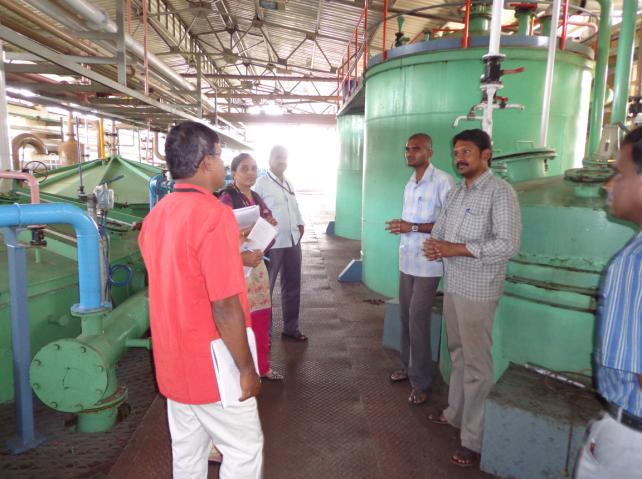
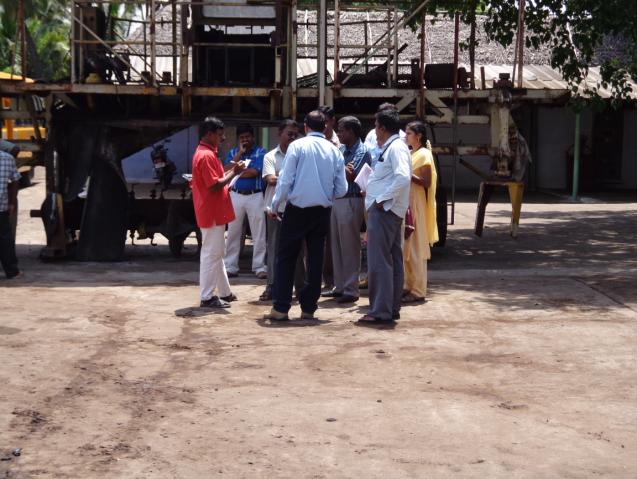
ANNEXURE II
List of Books Purchased in 2014-15
Name of the Book
Title of the book
Microbial Ecology and
Agricultural Microbiology
Microbial Biodiversity
Gene cloning & DNA
Industrial Applications of
Microbiology Biofertilizers for
sustainable Agriculture
Discount @ 20% 2,873.00
Net amount 11,492.00
Introduction to soil
Net amount special price
5,755.00
33-34-35, Sreeji Apts.,
Biofertilizer Technology
Net amount
6,715.00
Beneficial Plant Microbe
M/s T.R.Publications Pvt Ltd.,
A-32, 3rd floor,
35, South Boag Rd,
Discount @ 20% 3,174.00
T Nagar, Chennai-
Net amount 12,695.00
Food Microbiology
3/5C, Sumitha Nagar,
Umesh Kumar Soil & Agricultural
Microbial genetics
Net amount
3,592.00
NET AMOUNT 34,494.00
(Rupees Thirty four thousand four hundred and ninety four only)
ANNEXURE III
Research Accomplishments/ Salient findings
Effect of long-term nutrient managements on biological and biochemical properties of semi-arid
tropical Alfisol during maize crop development stages-This study has revealed that the overall biological properties of Alfisol were controlled by the long-term nutrient management adoptions and to some epxtend by the growth stages of maize and their interactions.
Under this project, microbial biomass, counts of observed microbial communities and hydrolytic
enzymes were highest in organically managed and integrated nutrient management enforced soils at active vegetative stage of maize crop.
The inorganic nutrient amendments and no fertilizer application had same magnitude on the
biological and biochemical properties of soil throughout the maize crop growth. In general, the amplitude of interaction effect was higher order in OM and INM at vegetative stage than the mean values of the treatments at flowering, harvest and other samples. The respiration study indicates that metabolic quotient of the soil was significantly increased in early stage of maize due to agronomical disturbances and subsequently declined and stabilized during vegetative and flowering stages of maize.
Under the project on ‘Development of process for microbial delignification of lignocellulosic
biomass/waste for fuel ethanol production' a potential laccase producing fungal isolate MSF2 was isolated from wood decay sample was identified which produced higher laccase yield of 1944.44 U.ml-1 in much shorter period (12 days)
A maximum lignin removal of 47.6 and 32.9 % was achieved using a novel biodelignification
process compared to enzymatic removal of 29.7% and 20.22% in wood and corncob, respectively
Higher tyrosinase producing actinobacteria Streptomyces sp JS-8 was isolated
A novel High laccase producing fungi Basidiomycete was identified and characterized
Attempts were made to isolate some thermophilic yeast from Himachal Hot Springs (Manikaran
and Kalath). The positive isolates were further purified and their screening and confirmation of hydrolytic enzyme production is under progress.
Lignin degraders were isolated and selected based on guaiacol oxidation and further confirmed
for their extracellular enzyme production in SEA media containing guaiacol (0.04%).
Lignin depolymerization was carried for kraft and black liquor lignin using crude laccase enzyme
and analysis of lignin derived products using GC-MS is under progress.
Twelve algal isolates viz., Navicula, Unkown diatom, 4 Chlorella sp, Oscillatoria sp, Tolypothrix
sp, Synecococcus sp, Scenedesmus sp, Oedogonium sp, and Spirogyra sp were obtained by enrichment technique. Of which, four dominant, fast growing and lipid rich algal strains viz., Hindakia, Chlorella, Scenedesmus and Chlamydomonad) were identified by phylogenetic studies
The stage-specific inoculants for rice was mass produced and its shelf life was assessed. All the
inoculants has more than 1010 cells per ml. The inoculation of inoculants in the tray-based nursery enhanced the growth and biochemical constituents of rice. Field experiment to assess the impact of stage specific inoculants to rice cultivar ADT45 is in progress.
SCAR Primers designed for detecting Azospirillum strains performed well to discriminate the
target strain from others with very high accuracy and sensitivity. The primers can detect the strains even at low ratio (about 5%) of target in a population.
A simple Sephadex matrix based DNA extraction assay has been developed to elute DNA from
the microbial inoculants with high quality and ready-to-use for PCR.
The MPN-PCR method has low efficient (about 100 times) in detecting the inoculant than
conventional MPN, however, can also used as quality standard, as the detection limit is in the range of inoculant cell load per ml.
The detection limit of SCAR markers to the Azospirillum strains is in the range of 104 cells per ml. Azospirillum (Az 204), Phosphobacteria (Ps1), Potash bacteria (KRB9) and Pseudomonas (Pf1)
were compatible under in vitro condition to develop the liquid bioinoculants. pH of the mixed liquid bioinoculant was slightly reduced from 7.5 to 6.5.
Among the four bioinoculants, population load was slightly reduced in potash bacteria, whereas
the others were not reduced that much.
The effect of fluorescent pigment was very mildly affected the growth of potash bacteria based
on inhibition zone formed in agar well diffusion method and others growth was not affected.
Ten Burkholderia isolates were obtained from the rhizosphere of different crops viz., B1 and R1
were found to have phosphate solubilizing, nitrogen fixing and antagonistic activity against Macrophomina phaseolina.
B1 and R1 were found to produce 36 and 32 mg of P/100 ml broth respectively. B1 and R1 were found to produce IAA 12 and 10 µg/50 ml broth respectively. These two isolates
were identified as Burkholderia thailandensis and Burkholderia vietnamensis.
Shelf life studies of the bacterial consortia experiment revealed that bioinoculants can be stored
upto 120 days under refrigerated storage against 90 days under room temperature.
Field studies at CRS, Aliyar Nagar and ORS, Tindivanam revealed that seed treatment of
groundnut with consortia along with soil application@5Kg/ha on 45 DAS registered the highest pod yield, shelling %, 100 kernel weight and compared to seed treatment alone with soil bacterial consortium.
Gluconacetobacter diazotrophicus was isolated from sugarcane stem and characterized using
standard microbiological techniques
Gluconacetobacter isolate showed better dissolution of phosphate and zinc nutrients
Standardized the protocol for direct shoot induction with modified MS media with BAP 4 ppm+
NAA 2 ppm. Emergence of shoot was observed on 120DAI when compared to other treatments with BAP and NAA.
Average of three to four regenerated plantlets was obtained through this treatment
For in vitro acclimatization, the plantlets were dipped in Methylobacterium bacterial suspension
(108 cells/ml) before planting has better survival than the uninoculated tissue culture plants.
Physico-chemical and biological properties of sago effluent collected from a small scale sago industry (A.R.Durai, ARD with production capacity of <2000kg day-1), a medium scale sago industry (Sree Selliamman Sago, SSS with production capacity of 5000kg day-1) and a larger scale sago Industry (Vel Murugan Sago, VMS with production capacity of >10000kg day-1) during peak season were analysed
When the organically highly enriched sago factory waste waters were channeled through biogas
plants, the pH raised to about 7, the population densities of fermenting and cyanide tolerating bacteria and methanogenic archaea significantly increased, introduced cyanides were consumed, but the BOD decreased only by around 32%, indicating scope for further purification of the sago effluent for safe recycling or reuse
Among the sugars, myo-inositol was found to be highly concentrated in untreated sago
wastewater from all the three sago factories. After biomethanation process, all the sugars were reduced to lower concentration, while the glucose was found to be completely disappeared in the biogas plants of small and large scale factory.
Macronutrients such as potassium, magnesium, calcium and sodium were highly concentrated
in untreated and biomethanated sago wastewater from all the three factories. Among them, potassium was highest in untreated as well as biomethanated wastewater from all the three sago factories. While iron was least in untreated wastewater, it was found to be completely disappeared after biomethanation in all the three factories.
Regarding the micronutrients, zinc was observed to be in higher levels in untreated wastewater,
which completely disappeared during treatment in the biogas plants in all the three factories. Similarly, the concentration of copper completely disappeared during biomethanation of wastewater from the large scale factory.
A total of ten cyanide degrading (CD) bacteria were isolated from the sago wastewater collected
from the three factories using enrichment technique and all the isolates were screened for their ability to utilize cyanide as a nitrogen source.
Five starch degrading (SD) bacterial isolates was isolated from sago wastewater from the three
factories using starch agar media and their starch hydrolyzing ability was determined by observing the clear zone produced in the respective medium when flooded with iodine after 48 h of incubation.
Identified bacteriophages as a new biocontrol agent for the management of soft rot disease
losses under post harvest condition. The technology was standardized for the slow release of bacteriophages when treated with tomato and potato
Technology was optimized for the bacteriophage coating of tomato and potato Entrapment of bacteriophages in a water soluble edible protein for the sustained / slow release
of phages in coated tomato and potato
Fig.1. Identification of an efficient lignolytic fungus
ANNEXURE IV
Technology Transfer: Success story
Bacteriophages – A Novel Biopreservative for Vegetables
Bacteriophage based biocontrol measurements have a great potential to enhance
microbiological safety of food at all stages of production in the classic "farm to fork" approach throughout the entire food chain supply system. The bacteriophages are highly host specific in nature, and remain inert unless there is an interaction between host bacteria and phage. To increase the efficiency of the phages and its survival in the fresh vegetables, water soluble, non toxic nano thickness film was developed. The phages were encapsulated in water soluble edible emulsion and fresh vegetables were immersed in the solution for few seconds to form thin film of coating. The treated vegetables were shade dried for 15-30 minutes and can be packed. The water soluble emulsion treated vegetables can be stored for more than 10 days under room temperature depending on the nature of vegetables and fruits. The treated vegetables should be washed in tap water before consumption. The technology is ecofriendly, safe to handle, no residual effect & safe to human consumption. The technology is more useful for farmers, traders retailers & malls. This technology is non toxic to human consumption and can be done either manually or by automation. The technology developed is under progress for standardization of various parameters for further improvement.
Bacteriophage treated potatoes and tomatoes
Novel biodelignification process for lignocellulosic biomass
• Isolated ligninolytic fungi from decayed wood and screened for substrate based laccase enzyme
• The positive isolate MSF2 was identified using 18S rRNA sequencing.
• Enzyme production of MSF2 in a simple medium containing inducer had higher laccase yield of
1944 Uml-1 within a shorter period of 12 days.
• A low cost enzyme production technology was carried using natural lignocellulosic substrates
under Solid (3345.06 Ug-1) and submerged (2666.67 Uml-1) fermentation.
• Delignification process developed using the crude laccase enzyme with solvent recovered a
maximum lignin removal of 48.17 % and 33.81 %, in wood and corncob respectively.
LIQUID BIOFERTILIZER PRODUCTION USING TANGENTIAL FLOW
FILTRATION SYSTEM
is a rapid and efficient method for separation and purification of
biomolecules. TFF can be used to concentrate and desalt sample solutions ranging in volume from 10 mL
to thousands of liters. It can be used to fractionate large from small biomolecules, harvest cell
suspensions, and clarify fermentation broths and cell lysates. There are several options for culture free
techniques (for example, gradient density centrifugation) to concentrate the target to a sufficient level
that is compatible with downstream detection platforms. Although sensitive, techniques such as
centrifugation are expensive and restricted to low sample volumes. In comparison, filtration based
methods do not have a restriction of volumes and use relatively simple equipment that is compatible
with field testing. TFF is a cross flow system that enables high filtration rates of large volumes of sample
without excessive pore blocking as experienced with dead end filtration techniques. In tangential Flow
Filtration, flows are directed across the membrane surface. The sweeping action of the fluid restricts
retained material from settling and eventually reduction flow. It is a pressure driven membrane process
used to concentrate separate or purify macromolecules.
USE OF TFF SYSTEM
• TFF system can filter/separate the microbial cells from liquid broth and concentrate the cells.
• The concentrated cells can be dissolved either in suitable minimal broth or water soluble carrier
• The inhibitory effect of toxic metabolites can be prevented by separation of microbial cells from
the fermentation broth
• Highly suitable for biofertigation • Can be stored for longer period without losing the cell viability
ANNEXURE V
Infra-structures developed
Two 500 litre fermenters were installed to produce liquid biofertilizers to meet the demand
One 62.5 KVA generator was installed to get continuous power supply in the event of power
An air conditioned modern lecture hall with LCD Projectors, Computer with Internet facilities,
Public address systems, TV and DVD players has been developed.
Laboratories have been upgraded for carrying out quality research in leak proof, dust free
and researcher friendly environment.
A library containing about 550 books with browsing facilities for trainees students and staff
has been established under ICAR CAS/CAFT programme at the Department of Agrl. Microbiology, TNAU, Coimbatore.
Following are the equipments available in the department:
Electrophoresis units and
Hofers; Bangalore
Biorad; Bangalore Genei
Refrigerated centrifuge
Microplate reader
Spectrophotometer GC
PCR thermocycler
Eppendorff, Applied
Syngene, UK, Biorad,
Biosystems, Biorad
Fourier Transform-Infra –
Red Spectroscopy
Addition to this, following equipments were purchased in 2013 -15
Instrument
Ultra volume Spectrophotometer
Class II Biological safety cabinet
PCR thermocycler
Applied Biosystems, USA
Incubator Shakers
Orbitec, India; Labcompanion, USA
High temp incubator
Labcompanion, USA
Gel Documentation system
Sample blender for food analysis
Iso Electric Focusing system
Protein Purification system (FPLC)
ANNEXURE VI
Research articles published (2014-15)
Adhilakshmi M, Paranidharan V, Balachandar D, Ganesamurthy K & Velazhahan R (2014)
Suppression of root rot of mung bean (Vigna radiata L.) by Streptomyces sp. is associated with induction of peroxidase and polyphenol oxidase. Arch Phytopathol Plant Protect 47 (5):571-583.
Adhilakshmi M, Latha P, Paranidharan V, Balachandar D, Ganesamurthy K & Velazhahan R (2014)
Biological control of stem rot of groundnut (Arachis hypogaea L.) caused by Sclerotium rolfsii Sacc. with actinomycetes. Arch Phytopathol Plant Protect 47 (3):298-311.
Balachandar D, Doud MS, Schneper L, Mills D & Mathee K (2014) Long-term organic nutrient
management fosters the eubacterial community diversity in the Indian semi-arid alfisol as revealed by length heterogeneity–PCR. Commun Soil Sci Plant Anal 45 (2):189-203.
Bhattacharyya P, Roy KS, Dash PK, Neogi S, Shahid M, Nayak AK, Raja R, Karthikeyan S,
Balachandar D & Rao KS (2014) Effect of elevated carbon dioxide and temperature on phosphorus uptake in tropical flooded rice (Oryza sativa L.). Eur J Agron 53:28-37.
Chinnadurai C, Gopalaswamy G & Balachandar D (2014) Long-term effects of nutrient
management regimes on abundance of bacterial genes and soil biochemical processes for fertility sustainability in a semi-arid tropical Alfisol. Geoderma 232-234: 563-572.
Cibichakravarthy B, Kumutha K & Balachandar D (2014) Arbuscular mycorrhizal fungal diversity
in phosphorus-deficient Alfisols of a dry North-western agro-ecosystem of Tamil Nadu, India. Ann Microbiol:1-11. doi:10.1007/s13213-014-0845-8.
Iniya Kumar Muniraj, Sivakumar Uthandi, Zhenhu Hu, Liwen Xiao, Xinmin Zhan.2015. Microbial
lipid production from renewable and waste materials for second generation biodiesel feedstock. Environmental Technology Review, DOI: 10.1080/21622515.2015.1018340.
Jaivel, N., R. Rajesh, C. Uvarani and P. Marimuthu. 2014. In vitro Antimicrobial Evaluation of
Compound Derived from Streptomyces sp. TC1 against Xanthomonas oryzae pv. oryzae. Journal of Pure & Applied Microbiology, 8(2), 1-12.
Jaivel, N., R. Rajesh and P. Marimuthu. 2014. Evaluation of antimicrobial activity against
bacterial leaf blight pathogen Xanthomonas oryzae pv. oryzae and antioxidant activities of Streptomyces sp. TC1. African Journal of Microbiology Research, 8 (40), 3558-3564.
Jaivel, N., C. Uvarani, R. Rajesh, D. Velmurugan and P. Marimuthu. 2014. Natural occurrence of
organo fluorine and other constituents from Streptomyces sp. TC1. Journal of Natural Products, 77, 2-8.
Jaivel, N., R. Rajesh and P. Marimuthu. 2014. Optimization of Lovastatin Production by
Aspergillus terreus under Various Fermentation strategies. Trends in Biosciences, 7(4), 658-662.
Jaivel, N., R. Rajesh and P. Marimuthu. 2014. Standardizing the extraction and evaluation of
antimicrobial fraction from Streptomyces sp. tc1 against Xanthomonas oryzae pv. oryzae. Life Sciences Leaflets, 54, 16-26.
Khambalkar, P., R. Sridar, M. Sivaji.2014. Isolation and characterization of Plant growth
promoting Rhizobacteria Burkholderia sp. J.Soil Biol.Ecol.34: 1-8
Nikita E. Chavarria, Shiyun Cao, Mary Holman, Dina Elbanna, Suzanne Rodriguez, Deanna
Arrington, Markus Englert, Sivakumar Uthandi, DieterSöll, and Julie A. Maupin-Furlow. 2014. Archaeal Tuc1/Ncs6 homolog required for wobble uridinetRNAthiolation is associated with ubiquitin-proteasome, translation, and RNA processing system homologs. PloS one 9 (6), e99104.
Ponvizhi Ramya, V., S. Gunasekaran and M.Senthilkumar. 2014. Genetic Diversity of soft rot
Pathogens in Potato of South Indian Origin. Research Journal of Biotechnology. Vol. 9 (5) :47-58.
Ponvizhi Ramya, V., S. Gunasekaran and M.Senthilkumar. 2014. Phenotypic identification of sour
rot pathogen of tomato in TamilNadu. Pestology vol. 38 (5) : 11-16.
Priyanka, S., M Sivaji and R Sridar.2014. Isolation and characterization of a novel multifunctional
sulphur oxidizing bacterium (SOB) and its use as biofertilizer. International Science Journal.1:28-34
Rajesh, R., N. Jaivel and P. Marimuthu. 2014. Muntingia calabura botanical formulation for
enhanced disease resistance in tomato plants against Alternaria solani. African Journal of Microbiology Research, 8 (20), 2059-2068.
Rajesh, R., N. Jaivel and P. Marimuthu. 2014. Antifungal metabolite from Muntingia calabura
root against early leaf blight of tomato. Journal of Medicinal Plant Research, 8(13), 523-528.
Rajesh, R., N. Jaivel and P. Marimuthu. 2014. Bioefficacy Muntingia calabura of botanical
formulation against Alternaria solani causing early blight in tomato. Journal of Mycology and Plant Pathology, 44(2), 166-171.
Rajesh, R., N. Jaivel and P. Marimuthu. 2014. Botanical formulation of Muntingia calabura for
the management of early leaf blight in tomato. Madras Agricultural Journal, 100 (1-3), 747-750.
Ramasamy, K., U. Sivakumar and K. Sara ParwinBanu.2014. Unravelling Plant Microbiome:
Proteins and Small Molecules in Signaling and Improving Plant health. Eds: Editor: K.RAMASAMY AND K. KUMAR, Published by NEW INDIA PUBLISHING AGENCY, ISBN: 9789383305834
Sarathambal C, Ilamurugu K, Balachandar D, Chinnadurai C & Yogita Gharde (2015)
Characterization and crop production efficiency of diazotrophic isolates from the rhizosphere of semi-arid tropical grasses of India. Appl. Soil Ecol. 87:1-10.
Selastin Antony, R., G. Gopalaswamy and M. Senthilkumar (2014). Exo polysaccharides
production of brinjal bacterial wilt pathogen Ralstonia solanacearum. Trends in Biosciences 7(16): 2229-2232.
Selastin Antony, R., G. Gopalaswamy and M. Senthilkumar (2014). Characterization of
devastating phytopathogen Ralstonia solanacearum from wilt infected brinjal plants from Mizoram, India. Life Science Leaflets Pp. 6-13.
Shenbagam. P., R. Sridar and M. Sivaji.2014. Developing Rhizobium Mutants for Enhanced
Nodulation in Green Gram Grown in Acid Soils. J.Soil Biol.Ecol.34: 9-16
Sivaji, M., S Priyanka and R Sridar.2014. Isolation and characterization of phosphate solubilizing
Burkholderia sp from crops rhizosphere. J.Innov.Agriculture.1: 1-6
Sivaji, M and R Sridar.2014. Antagonistic activity of Trichoderma viride and Pseudomonas
fluorescens isolated from Bt and non Bt cotton rhizosphere against Rhizoctonia solani. J.Soil Biol.Ecol.34: 60-69
Sivaji, M and R Sridar.2014. Effect of Bt cotton root exudates on functional enzymes in the
rhizosphere soil. J.Soil Biol.Ecol.34: 25-34
Sivaji, M and R Sridar.2014. Impact of Bt Cotton on the Functional Microbes in the Rhizosphere
Under In Vitro Condition. Trends in Biosciences. 7: 3475-3478
Sivakumar Uthandi and G.Kalaichelvan. 2014. Enrichment and Isolation of Bluish Purple
Producing bacterium. J. Soil Biol. Ecol. 34 (1&2) : 17-24.
Srinivasan, M., K.Kumar, K.Kumutha and P.Marimuthu. 2014. Establishing monoxenic culture of
arbuscular mycorrhizal fungus Glomus intraradices through root organ culture. J. Appl. & Nat.Sci., 6 (1):290-293.
Srinivasan, M., K.Kumar and K.Kumutha. 2014. Isolation and selection of efficient AM fungi
spores from sugarcane rhizosphere for in vitro AM inoculum production. Biochem. Cell. Arch., 14 (1): 89-93.
Srinivasan, M., K.Kumar K.Kumutha and P. Marimuthu. 2014. Comparison of colonization
potential of AM fungus Glomus intraradices cultured under In Vitro and In Vivo condition. Trends in Biosciences 7(3): 437-440
Srinivasan, M and K.Kumar. 2014. Production of Daucus carota hairy root for in vitro culture of
arbuscular mycorrhizal fungi., Res. J. Biotech 9(5): 38-41
Srinivasan, M., K.Kumar, K.Kumutha and P. Marimuthu. 2014. Influence of acetosyringone
concentration on induction of carrot hairy root by Agrobacterium rhizogenes., African Journal of Microbiology Research 8(26): 2486-2491
Sujatha, K., K.Kumar. 2014. Biotransformation of cyanide by native bacteria from sago
wastewater under anaerobic condition. Journal of Pure and Applied Microbiology 8(5): 4209-4214
Tamilselvi SM, Chinnadurai C, Ilamurugu K, Arulmozhiselvan K & Balachandar D (2015) Effect of
long-term nutrient managements on biological and biochemical properties of semi-arid tropical Alfisol during maize crop development stages. Ecol Indic 48:76-87.
ANNEXURE VII
Externally funded Schemes obtained in 2014-15
Development of efficient processes for
biomethanation and bioremediation of
cassava sago effluent by nitrogen amendments and Spirulina cultivation under HRAP system for safe recycling DNA fingerprinting of lignocellulose
degrading microbes isolated from
protected forest areas of Assam and Mizoram Evaluation of crop response of liquid
Dr.M.Gnanachitra
inoculants and their effect in rice nutrient
Authentication of recent bioinoculant
2014- 2017 Dr.R.Subhasini
strains of TNAU by physiological and
molecular profiling
Studies on the nutritional/anti nutritional
2014- 2017 Dr.R.Subhasini
changes in finger millet with
thermotolerant Pediococcus pentosauceus
Development of integrated
(biotechnological and nanocatalytic)
biorefinery for fuels and platform
chemicals production from lignocellulosic
biomass (crop/wood residues)' Centre of Excellence on MICROBES TO
Dr. U. Sivakumar
FEED THE WORLD: Plant-Microbe
interactions to boost Agricultural
Dr.D.Balachandar
Dr.K.Kumutha Dr.M.Senthilkumar
Formulation of microbial consortium of
Directorate 6.40
liquid formulation for sustainable
sugarcane production
Molecular detection and quantification of
Dr.D.Balachandar
shiga – like toxin producing Escherichia coli
in fresh vegetables
Lactic acid bacteria of functional interest in
2015-2017 Dr.R.Subhashini
nutrition of finger millet
Patents filed:
1. Sivakumar Uthandi, Sujatha Kandasamy, Iniyakumar Muniraj, Namitha
Purushothaman and Ramasamy Kumarasamy 2015.High level secretion and method
of laccase production by Hexagonia hirta and uses there of (645/CHE/2015)
2. Sivakumar Uthandi, Iniyakumar Muniraj, Anbu P.V, and Ramasamy Kumarasamy
2015. Novel Delignification process for biomass deconstruction of woody biomass and corn cob (under filing)
ANNEXURE VIII
Name of the biofertilizer
Quantity supplied (Kgs)
Amount (Rs.)
Carrier based biofertilizers (Kgs)
Azospirillum
Rhizobium
Azotobacter
Liquid biofertilizer (lit)
Azospirillum
Quality control analysis
Azospirillum
Rhizobium
Azotobacter
Mother cultures supplied
Azospirillum
Rhizobium
Azotobacter
400000/-
805490/-
ANNEXURE IX
ICAR – CAS in Agricultural Microbiology, Tamil Nadu Agrl. University, Coimbatore
List of training programmes conducted from the inception.
Title of the Training
Course Directors
Programme
(Rupees)
1997 - 98 Biofertilizer technology and
Dr P Santhanakrishnan 27.01.97 31.01.97
1997 - 98 Nitrogen fixing and
Dr P Santhanakrishnan
10.10.97 08.12.97
phosphorus Solubilizing microorganisms
1998 - 99 Phosphorus Solubilizing and
21.12.98 03.12.98 17
1998 - 99 Recent trends in symbiotic
Dr S Gunasekaran
01.03.99 14.03.99
Dr P Santhanakrishnan
1999 - 00 Microbial systems
Dr P Santhanakrishnan 01.07.99 15.07.99
1999 - 00 Recent advances in microbial
03.12.99 23.12.99
1999 - 00 Microbial interactions in soil
Dr K. Govindarajan
01.02.00 21.02.00
2000 - 01 Techniques in microbial
01.12.02 21.12.02
Dr V Udayasurian
2000 - 01 Bioconversion of cellulosic
31.01.01 22.01.01
10 2001 - 02 Techniques in Microbiology
11 2001 - 02 Microbial Transformations in
12 2002 - 03 Microbial inoculant
03.02.03 23.02.03
13 2003 –04 Microbial Processes for value Dr R Murugesan
04.02.04 24.02.04
14 2003 –04 Role of Microorganisms in P
03.03.04 23.03.04
nutrition of crop plants
Dr K Govindarajan
Microbial fermentations
Dr S Gunasekaran
01.02.05 21.02.05
16 2004 –05 Molecular techniques in
29.03.05 18.04.05
Dr D Balachandar
17 2005 –06 Recent advances in Microbial Dr T Natarajan
24.03 06 13.04.06
Dr D Balachandar
18 2006 –07 Microbial conversion of
Dr S Gunasekaran
08.11.06 28.11.06
biomass to biomolecules
19 2006 –07 Molecular techniques in
16.01.07 05.02.07
microbial diversity
Dr D Balachandar
20 2007 –08 Microbial products and their
21.01.08 10.02.08
application in food
21 2007 –08 Techniques in soil
09.02.08 29.02.08
microbiology with emphasis
22 2008 –09 Screening and isolation of
Dr G Gopalaswamy
02.11.08 23.11.08
anti-microbial compounds against plant disease
23 2009 –10 Bio-fuels from multiple feed
11.03.09 31.03.09
Dr S Gunasekaran Dr K Kumar
2010 –11 Mycorrhizal systems for
11.03.10 31.03.10
sustainable agriculture
horticulture and forestry
Current Perspectives in
Molecular Microbial Diversity
Microbial processes for value Dr R Murugesan
addition in food and
Dr S Gunasekaran
Microbiological processes in
Dr S Karthikeyan
soil carbon dynamics and
sequestration vis-à-vis
anticipatory climate changes
Faculty Training on Food
Quality and Safety
Dr. Z.John Kennedy
Management systems
Dr.M.Senthilmumar Dr.S.Gunseakran
Biocatalysts for fuels and
Dr.S.Gunasekaran
07.08.14 27.08.14
chemicals from biomass
Dr U Sivakumar Dr S Karthikeyan
Microbial mediated soil-
Dr R.Sridhar, Dr.
nutrient transformation
Dr. D.Balachander
Grants received and expenditure details for the past 15 years (in Rupees)
Source: http://proj.iasri.res.in/cbp/Data/Coordinator/213/Ag.%20Micro%20TNAU%20ICAR%20CAFT%20An%20Report%202014%2015.pdf
Imaginez-vous… Imaginez-vous… ne plus devoir passer du temps à chercher des solutions pour résoudre vos problèmes et passer enfin du temps à faire ce que vous aimez le plus. Imaginez-vous… ne plus devoir expérimenter produits après produits ou régimes après régimes mais atteindre enfin votre plus haut niveau de beauté naturellement pour le reste de votre vie.
EL PROCÉS DE CONSTITUCIÓ DEL BARRI SANTA MARIA DE PALAFOLLS Xavier Gimeno Torrent Protocol de recerca. Abril de 2012. Quan es parla, en aquest país, dels pagesos, es corre sempre el risc —i sobre aquest punt l'experiència és precisa— que se'ns atribueixi una tendència a usar la paraula pagès en el sentit despectiu i grotesc que anys enrera alguns papers humorístics indígenes donaren a la paraula. Aquest sentit despectiu existeix i és corrent trobar-lo entre persones cultivades, en les grans aglomeracions urbanes. En aquestes aglomeracions, s'hi solen trobar de vegades persones accentuadament pedantesques que tendeixen, pel mer fet de respirar, a creure que el seu paisatge urbà —generalment horrible— és el llombrígol del món i el desideràtum de totes les qualitats i de totes les quantitats. Respectem-los les il·lusions, car, si no les tinguessin, els seria massa difícil de resistir el lloc que habiten i la vida que porten.









